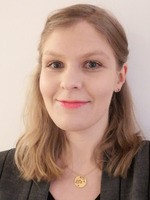The PhD defence and trial lecture will be streamed. The chair of the defence will moderate the disputation.
Ex auditorio questions: the chair of the defence will invite the audience physically present in the auditorium to ask ex auditorio questions.
→ Live streaming of trial lecture and disputation
→ Request for thesis copy (available until the disputation starts)
Trial lecture
Time and place: December 11, 2023; 10:15 AM, Lille Fysiske Auditorium (V232) - Fysikkbygningen
Title: "Why model the brain? The benefits, limitations and future challenges."
Main research findings
Perineuronal nets are protein structures that encapsulate certain neurons in the brain. They have been linked to memory retention and proposed to have a barrier function, as well as affecting properties of the neuronal membrane. As technical and monetary restrictions may limit experimental efforts, simulations can help shed light on the nets’ function.On a shorter scale, diffusion inside the nets can be studied through coarse-grained molecular dynamics simulations. From this, the resistance of the nets can be derived, providing an estimate as to how good of a barrier the nets actually are.If the nets are good barriers, the distance between ions on the inside and outside of the cell increases, leading to a reduced capacitance. This change may affect how the neuron fires electrical signals. The capacitance enters as a parameter in models of entire neurons, along with conductances through channels in the membrane.In this thesis, Kine Ødegård Hanssen uses these tools to study properties of the nets. She finds that the nets restrict diffusion, but that their resistance is small compared to the membrane resistance. She simulates neurons with and without nets, and finds that a capacitance change alone cannot explain results found in the literature.
Hovedfunn (Norwegian)
Perinevrale nett er proteinstrukturer som omkapsler enkelte nevroner i hjernen. De har blitt knyttet til hukommelse, og det er foreslått at de virker som fysiske barrierer, samt at de påvirker egenskaper til cellemembranen. Siden budsjett og teknikaliteter kan begrense mulighetene til å foreta eksperimenter kan simuleringer hjelpe oss å forstå nettene bedre.På liten skala kan vi simulere diffusjon inne i nettene ved hjelp av grovkornede molekylærdynamikk-simuleringer. Dermed kan vi utlede resistansen til nettene, som indikerer hvor gode barrierer nettene utgjør.Hvis nettene er gode barrierer vil avstanden mellom ioner på innsiden og utsiden av cellen minke. Dermed vil kapasitansen reduseres. Denne endringen kan endre hvordan nevronet sender elektriske signaler. Kapasitansen er en parameter i modeller av hele nevroner, i likhet med konduktanser gjennom kanaler i cellemembranen.I denne avhandlingen bruker Kine Ødegård Hanssen disse virkemidlene til å studere egenskaper ved nettene. Hun finner en redusert diffusjon i nettene, men ser at nettenes resistans er liten sammenlignet med membranresistansen. Hun simulerer også nevroner med og uten nett, og finner at kapasitansen alene ikke kan redegjøre for observasjoner gjort i litteraturen.
Adjudication Committee
- Professor Peter Jedlicka, Faculty of Medicine, Justus-Liebig-University, NeuroScience Center Clinical Neuroanatomy (Anatomy I), Goethe-University, Germany
- Professor Ausra Saudargiene, Neuroscience Institute, Lithuanian University of Health Sciences, Lithuania
- Professor Ørjan Grøttem Martinsen, Department of Physics, University of Oslo, Norway
Supervisors
-
Professor Anders Malthe-Sørenssen, Department of Physics, University of Oslo, Norway
-
Professor Gaute T. Einevoll, Department of Physics, University of Oslo, Norway
-
Professor Marianne Fyhn, Department of Biosciences, University of Oslo, Norway
-
Dr. Geir Halnes, Department of Biosciences, University of Oslo, Norway
Chair of defence
Professor Anette Eleonora Gunnæs, Department of Physics, University of Oslo, Norway
Candidate contact information
LinkedIn: Kine Ødegård Hanssen
Contact information to Department: Line Trosterud Resvold
